The Apple iPad Pro Review
by Ryan Smith, Joshua Ho & Brandon Chester on January 22, 2016 8:10 AM ESTSystem Performance
While the iPad Pro is important for some of its tertiary features, without the performance to back it up the user experience will inevitably suffer. In order to try and get an idea for how the iPad Pro performs as a whole we turn to our suite of performance benchmarks that stress a number of different areas including the CPU, GPU, memory, and internal storage.

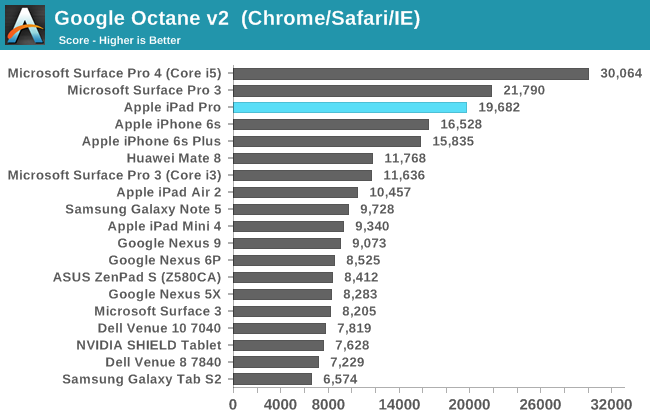
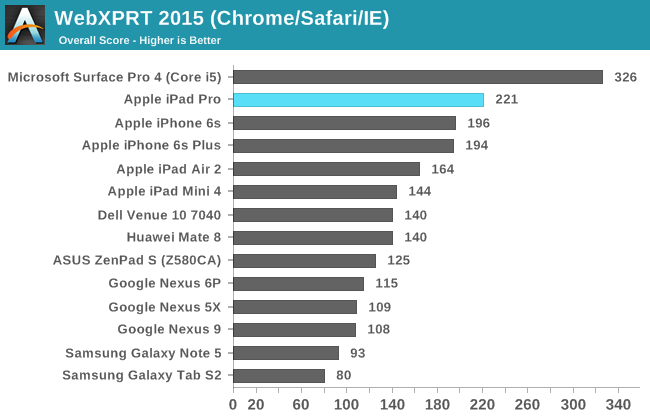
In the browser benchmarks, it's quite evident that the iPad Pro is far and away superior for browser performance compared to almost anything else on the market today, save the latest Surface Pros. This can be attributed to a few factors. One factor is that Safari has a number of optimizations that most Android browsers don't. The other factor is that the Twister CPU in A9X is just better suited for dealing with intense JavaScript, which is heavily reliant on single-thread performance. As the A9X only has two CPU cores that mostly rely on ILP to get acceptable levels of performance, the iPad Pro ends up doing impressively well in these benchmarks. I've found that this is also reflected in real world browsing performance, as the iPad Pro is less likely to choke on some popular JS-heavy tech websites than other devices with Chrome or an OEM-optimized browser. Quickly checking EmberJS performance tells pretty much the same story here as well.
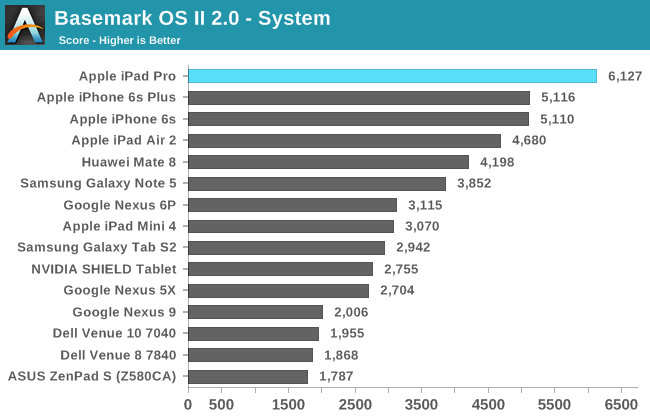
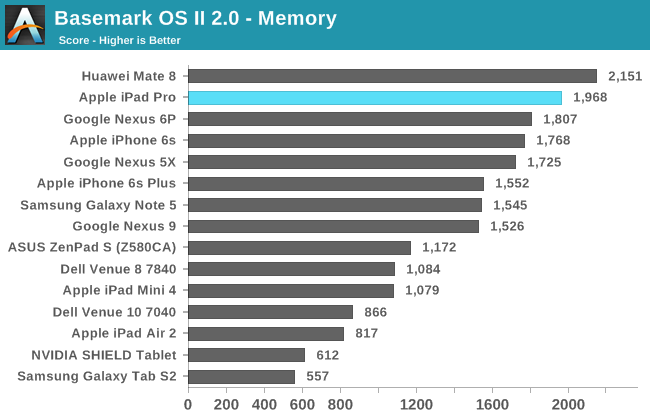
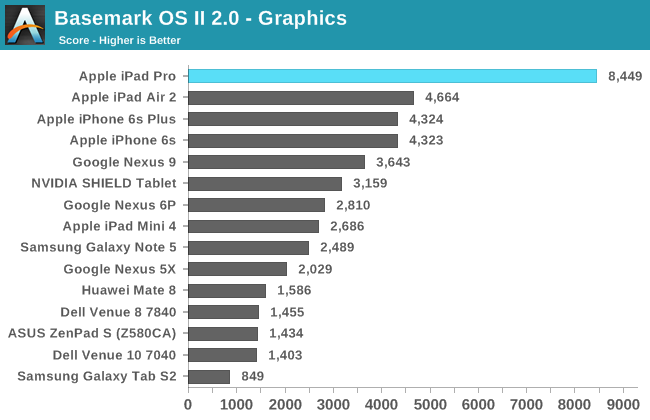
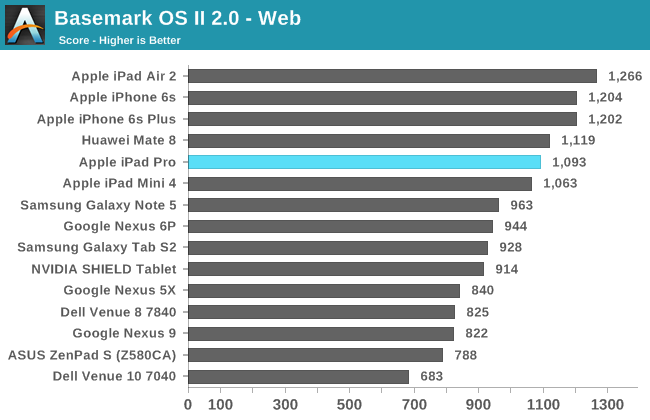
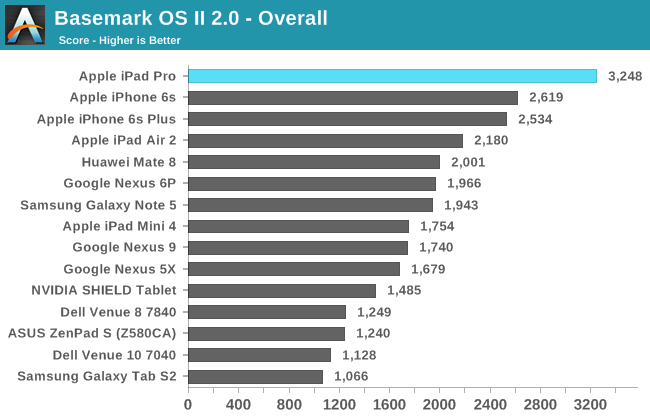
In Basemark OS II 2.0, the iPad Pro pretty handily sets the record for performance by virtue of its GPU and CPU performance. For whatever reason there's some sort of hang-up in web browsing performance, which could be due to some sort of code path that doesn't respond very well to additional ILP. Whatever the case, performance isn't too far behind the iPad Air 2 here by virtue of higher IPC and clock speeds. Overall, the iPad Pro seems to be quite performant for everyday tasks.










408 Comments
View All Comments
Qwertilot - Friday, January 22, 2016 - link
Especially for stuff like newspapers and magazines - its an a4 sheet of paper, so everything is the right size :)Mine mostly sits on a book stand and does that/internet/bits of TV etc. Exceedingly good for that.
Speedfriend - Friday, January 22, 2016 - link
Why is there no near iPad Air with the A9X. Is it because the TDP is too high? Why do we never see any attempts to measure power for the Apple SOCs? Is it because Apple remove publications from review and press access lists if they attempt to delve too deeply?WorldWithoutMadness - Friday, January 22, 2016 - link
Watch your back... you delve too deeply.Ryan Smith - Friday, January 22, 2016 - link
"Why do we never see any attempts to measure power for the Apple SOCs?"Because it's destructive, which means we can't do it to our review units. We'd need to buy units specifically for it, and even then there's a good chance we'd simply break it due to how difficult it is.
It's one of those things I'd like to do, but it requires a lot more in the way of resources than you'd otherwise expect.
Kevin G - Friday, January 22, 2016 - link
Perfectly understandable for review units and products just hitting the market. However, I suspect Anandtech has a few drawers full of tablets and phones that are no longer in active use/loaner review units which could be sacrificed for this data. Acquiring older units from the used market would be a cost effective way to get this data too.An alternative would be to partner up with a site like iFixit to help split the cost of the hardware. They take it apart and Anandtech would pay for a functional, already disassembled unit.
The difficult part would simply be getting the time to sit down and so this. :)
nathanddrews - Friday, January 22, 2016 - link
The foil is strong with this one.name99 - Friday, January 22, 2016 - link
We don;t need to resort to crazy conspiracy theories. Some possibilities include:- Yields from TSMC on the SoC weren't high enough. Or the variant
- Apple was worried that even with TSMC and Samsung making A9/A9X, there wasn't enough capacity to make all the SoCs they needed for iPhone AND new iPads, so they limited themselves to just the halo model (which they know will sell in smaller quantities).
- Apple want the next iPads to have 3D Touch and the screens for that were not ready in quantity. (This is the option I would bet on).
- Apple want the next iPads to have some other nice new feature (like at least two, perhaps four) speakers and that hardware is not ready in quantity.
I would not be at all surprised to see Apple release the next gen iPad Air and mini in say March or April (and perhaps to maintain those dates from now forward, to spread demand somewhat throughout the year instead of all peaked in Sept/Oct).
khon - Friday, January 22, 2016 - link
It's not a "pro" tablet when it only runs mobile software, and there is no possibility of using a mouse or trackpad.It's a larger iPad for students to take notes on, or for people who want a bigger screen when they're sitting on the couch.
blackcrayon - Friday, January 22, 2016 - link
It runs whatever software someone chooses to write for it, within its capabilities.What if your profession was doing digital sketches? Talk about narrow-minded.
rabastens23 - Friday, January 22, 2016 - link
What if you profession goes beyond doing just digital sketches tho? Let's open up that mind and admit the iPad Pro, for all its qualities, doesn't fit most professional needs - if anything, because apps are not available.